|
[Front Page] [Features] [Departments] [Society Home] [Subscribe]

Electronic Mailbox
 
The following have been selected from the questions received on the ASGAP World Wide web site over the past few months. You're welcome to comment on any issue concerning Australian native plants....growing, propagating or appreciating (even loathing!) ... anything.
If necessary, bung a message in a bottle if your net connection goes down!!
....and, if you'd like to contact any of the correspondents and no email address is listed, please feel free to do so through the editor.

Planting around a Pool
We have recently moved into a new home and have built a swimming pool in a small back yard. We both seem to have purple thumbs and most things we want to grow die and things we want to die grow.
 
There is only about 1 metre between the pool and the side fence and the pool is about 7 metres long. Sun is along that side most of the day and it is well drained.
We like things that are evergreen but nothing that will grow more than about 2 metres high and can be sculptured if required. It needs to have a non intrusive root system and preferably fast growing.
Please help us - we have no idea what to get - we have been to several nurseries but can't find the information we need regarding planting around chlorinated pools.
Thanking you for your time in help.
Regards
Kerrie & Wil Maartensz
It's difficult to be specific as I don't know where you are and what the climate might be like.
Generally, the odd splashing of chlorinated water doesn't do any harm to most native plants that you're likely to obtain, so I really wouldn't worry about it.
Generally suitable plants would be the smaller types of bottlebrush (eg "Capt. Cook", "Anzac", "Little John" ), melaleucas and tea trees. All of these take pruning well so they can be readily trimmed if they get too wide.
I'd also consider Banksia spinulosa - there are quite a few forms available and most are less than 2 metres. They flower in autumn/winter whereas the bottlebrushes etc are more spring flowering.
Among the Grevilleas, "Robyn Gordon" and "Superb" are good although they might spread a bit too much. But generally any small grevilleas recommended by a local native plant expert would be OK. Grevilleas generally flower in winter and spring.
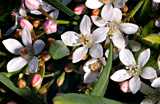

| |
A few others that grow well over a wide climate range include:
- Long-leaved wax flower, Philotheca (formerly Eriostemon) myoporoides - much under rated but beautiful in flower and tough as old boots!
- Banksia paludosa (low growing form) - very hardy and attracts birds (like all banksias)
- Phebalium squamulosum - lots of small, starry yellow flowers.
- Tall kangaroo paws (Anigozanthos) - "Gold Fever", "Yellow Gem" and "Big Red" are good, hardy ones.
Select a thumbnail image or highlighted name for a higher resolution image (28k and 40k).
|
There are lots of other possibilities.....If you haven't already done so, take a look at the list of specialist nurseries on our web site. You might find one not too far away. They should be able to give good advice and suggestions for your specific conditions.

Cadaghi
I would like to enquire about Eucalyptus torelliana (Cadaghi) = Corymbia torelliana - also nicknamed, "Trilliana".
I have some of these trees in my yard. Which I think are beautiful. Recently someone has remarked to me that these "Trilliana" trees are dangerous to some of our native wildlife like native bees. They believe the sap from the trees poisons the bees. I would like to know if this is true or not.
Another question....Is this tree a native tree of Australia as I was told that it was not?
Can you please give me some verification on this issue.
Anita Parsons
parsonsa@topaz.cqu.edu.au
I've never heard of any suggestion that the sap is poisonous to wildlife. It seems unlikely that it would be dangerous to native bees as the tree and the bees have evolved together - both are native. You could take a look at the "Aussie Bee" site - they would have all of the relevant info.
Corymbia torelliana occurs naturally in North Queensland from Cairns to Townsville.

What's in a Name???
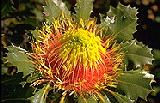
|
|
I am doing a university research project and I am required to know the two oldest generic names for the genus Dryandra and which is the oldest. I am having great difficulty finding the answer so if you have any idea I would appreciate it if you could email me.....
Select the thumbnail image or highlighted name for a higher resolution image (30k). Photo: Margaret Pieroni
|
Corinne Gaskin
Western Australia
Hmmm......Interesting!
Nothing immediately came to mind so I dragged out my trusty copy of "Waratahs Banksias and Grevilleas" by John Wrigley and Murray Fagg. It describes all of the Australian members of the Protea family. It would be worth getting hold of (published by Collins, 1989).
This is what they say......
"Dryandra was not the first name published for this genus, as in 1809 Joseph Knight published the name Josephia in his work, "On the cultivation of the natural order of Proteeae". He attributed the name to Robert Brown and said, 'A genus most happily selected by Mr Robert Brown, to bear the christian name of his great patron' (Sir Joseph Banks). Brown, however did not take up this name and in 1910 published the name that is now accepted" (Dryandra).
As far as I can ascertain, Josephia and Dryandra are the only two names to have been used although Wrigley and Fagg mention that Dryandra was earlier used for a genus in the Euphorbiaceae.
Hope this helps.

Coffee and Plants
I am in the 5th grade and need help with the following question for a science project.
Why does watering a plant with coffee help it grow so healthy?
Please help me - I have researched on the internet and can not find anything specific.
Thank you.
jkbt@lemoorenet.com
Well....while I'm reasonably expert at drinking coffee (strong and black and definitely not instant!), I'm no expert on its potential for plant nutrition. I do assume we're talking about cold coffee......
It seems to me that coffee would not have sufficient plant food to be of much use to plant growth on its own.
The majority of plants grown in gardens prefer acidic soils and, as I understand that coffee is slightly acid, the coffee solution or coffee grounds may help keep the soil conditions to the plant's liking. However, unless other plant foods are also provided (nitrogen, phosphorus and potassium, mainly) the coffee won't really help the plant in the long term.
Some plants prefer alkaline soils so adding coffee to these plants may cause them to become sick.
So...in summary, I don't believe that using coffee on plants has any dramatic effect on plant growth at all.
.....but I'm prepared to stand corrected if anyone has expertise to offer.

What's a Lignotuber?
I have found difficulty finding information about lignotubers. Can you help?
Marg
Australia
You bet!!!
A lignotuber is a woody swelling that occurs at or just below ground level on many fire tolerant plants. The lignotuber acts as food storage and as the site of regenerative buds which form new stems if the above ground parts of the plant are destroyed, usually by fire.
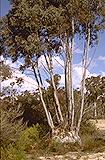 |
Lignotubers don't often get as large as this! Several trunks arising from a lignotuber on Eucalyptus rossii in the central west of New South Wales
Select the thumbnail image or highlighted name for a higher resolution image (52k).
|
Lignotubers occur on many plants but are most commonly seen on eucalypts that occur in areas subject to frequent fires. Eucalypts which have lignotubers form them very early following germination. A small lignotuber will often be seen on seedlings less than 300 mm high.

Where Have all the Flowers Gone?
Just wondering if you could suggest why my Hibbertia obtusifolia has stopped flowering. I put it in some sandy soil (reflecting its natural habitat) before Christmas, where it appeared to be thoroughly enjoying the conditions (with many flowers - 15 on Chrissy day). Then, all of a sudden, it stopped producing flowers, despite the "flowers profusely for most of the year" tag.
Could this be related to the soil it is in ? Will it ever flower again ?
Stephen Bell
Newcastle
I'm afraid this is probably a case of the plant label being a bit optimistic.
In my experience, H.obtusifolia usually flowers in late winter through to early summer. It can vary a bit depending on the climate where the plant is being grown. There may be flowers at other times of the year but they would normally be spasmodic.
Provided it's healthy, there's no reason why it won't flower again later in the year.

Cold Clematis
I live in Derbyshire, England.
Today I have potted on three seedlings of Clematis aristata that I obtained the seed for from The Alpine Garden Society.
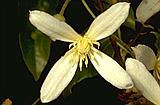
|
|
Our minimum temperature here in winter is -7oF. I would like to know where the natural distribution is of this plant in Australia and if it could be described as hardy.
Select the thumbnail image or highlighted name for a higher resolution image (30k).
|
Martin Froggatt
mfroggatt@clara.co.uk
There are some details of distribution and other info on our web site.
I don't think it's possible to answer your question satisfactorily as we don't get temperatures as low as -7oF (-22oC) except in alpine areas and C.aristata is not an alpine plant. So we just don't have any experience of growing under the sort of conditions you describe.
The species does occur in Tasmania where winter temperatures might get down to 10-15oF for short periods but whether it could withstand your winters is dubious.
If your seed was derived from more northern clones, the chances of problems would be even greater.
I'd really like to hear how these plants progress.

Planting Problems
I hope you are able to help us with our question. We are currently deciding what to plant in our garden bed in Yarraville, Melbourne. It's a north-facing bed which gets full sun. It is protected from strong winds. The soil is friable and well drained, but would be more clay than sandy. We plan to plant native grasses and the groundcover clay wattle and were hoping to plant a bull banksia (Banksia grandis) or dwarf apple (Angophora hispida). We've been advised by one nursery that we would be best not to plant such a banksia as they like light, sandy soil only.
Another nursery has suggested that we could plant one of these if we build the bed up with some sandy loam. Our other option is either a dwarf snow gum or Banksia robur. Do you have any thoughts/advice for us?
Catherine Malcolm
c.malcolm@vca.unimelb.edu.au
My knowledge of growing Australian plants in Melbourne is based mainly on talking to Melbourne growers and several visits there over the years. You might like to try the Victorian Region's web site if my response doesn't fully answer your question.
Firstly I would be wary of bull banksia. Western Australian plants generally can be difficult in the eastern states and although Melbourne is kinder to them than Sydney, you have to be careful. I wouldn't expect B.grandis to be a long term proposition irrespective of the soil. It's not true that all banksias like light, sandy soil - some do but there are lots that will do well in heavier soils, climate permitting. Banksia media would be a better bet if you particularly want a western banksia but one of the good forms of Banksia spinulosa would be more reliable.
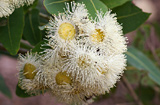

|
|
I would expect Angophora hispida to be reliable provided the drainage is reasonable. Banksia robur is also a hardy plant that I would expect to do well - it will tolerate heavier and wetter soils than many other banksias.
Building garden beds up is a good idea if drainage is suspect and sandy loam is a reasonable type of soil to use. Built-up beds allow a greater variety of plants to be grown.
I can't give any advice regarding the snow gum - I would expect that it would prefer a colder climate but I have no direct experience with it.
Select the thumbnail image or highlighted name for a higher resolution image (49k and 43k). Photos: Brian Walters (top), Keith Townsend (bottom).
|
Generally, if you visit one or more of the specialist native plant nurseries listed on our web site, I would be pretty confident that they would give good advice.
Hope this helps.

More Planting Problems
I was wondering if you could help me with a problem I seem to have. This spring (1999) I built a new garden bed using sandy loam and a little bit of compost for humus at a 1 to 7 (sand) ratio.
I have had pretty good luck with my garden so far but I have lost a few things. My Hakea cuculata grew like mad and dropped dead after 3 months (I think it got too much water). I tried it two more times with the same result. So, I have built up the spot and included a coarse sandy gravel and so far it is OK.
My Damperia purpurea had a lot of yellow leaves but is still alive and my alpine grevillea - Grampians form (Grevillea alpina) has suddenly dropped dead, well almost (as of 7-4-2000). The grevillea went yellow and now the leaves are browning and drying up. We have had a severe drought in Alexandra this year so loosing a few hasn't surprised me but the alpine grevillea has me worried.
 |
Dampiera purpurea (top) is usually a reliable plant in temperate climates. It often suckers and produces a colourful display in spring.
Grevillea alpina (bottom) occurs in a number of forms and is variable in flower colour and growth habit.
Select the thumbnail image or highlighted name for a higher resolution image (27k and 51k).
|  |
Is there anything that my garden might be missing minerals etc.... ? I sure would appreciate any help you can give me.
Brenda Galey
Alexandra, Victoria
It's difficult to be definitive but a few possibilities come to mind.
- I doubt that problems are due to mineral deficiency but you would need a soils expert to determine this.
- How is the drainage? The Hakea and Grevillea in particular need very good drainage.
- Have you fertilized? Again the Hakea and the Grevillea can be very sensitive to excess fertilizers, particularly to excess phosphorus. Their specialised proteaceous roots can take up toxic amounts. It's best to fertilize these species sparingly and only use slow release types.
- Was the compost well aged?
- It could just be that the plants aren't suited to your climate..... climate can play a major role in plant hardiness. For example I wouldn't even try H.cucullata here (western Sydney) because it is just too humid in summer. I've also tried many G.alpina without success.
- G.alpina is a very variable plant and occurs in many areas. It could be that the Grampians form you are growing is not suited to your area.
Not much help, I'm afraid.......

Mixed Up Eucs!!
Hello, I have got myself into a slight predicament.
Having sown Eucalyptus macrocarpa and E.caesia respectively, I then rearranged the containers when putting them out. The whole lot (approx 20+) germinated at roughly the same time but whereas it is now very obvious that there are two different plants involved, I no longer know which is which! One lot exhibits typical gum characteristics and has broad sagitate leaves, thicker at the stalk and then rapidly tapering but the other....it rather resembles coreopsis except that the leaves are somewhat thicker and coarser.
Where can I access drawings of juvenile leaves pertaining to E.macrocarpa and E.caesia? I am beginning to suspect that what I have - is neither! Thanks for any help!
John Wolfe
Australia
We've all done it!!! Just today I potted up some Pandorea cuttings which are either "Golden Showers" or "Snowbells". I'll just have to wait until they flower!
I don't know of any readily accessible drawings of juvenile leaves. The following descriptions are from "Field Guide to Eucalypts" Vol 2 by Brooker and Kleinig:
macrocarpa - sessile or very shortly petiolate, opposite, ovate, often amplexicaule, to 24 x 11 cm, dull glaucous, many side veins, reticulation very dense, with few small, intersectional oil glands or apparently glandless
caesia - petiolate, alternating, cordate to 8 x 6 cm, concolourous, very glossy, green.
What that means is ....I wouldn't be throwing them out just yet!
I suspect that the odd looking one is E.macrocarpa - if so, it will retain broad, greyish leaves as it ages while E.caesia should develop typical eucalypt leaves.

Mistletoe - Is it a Problem?
We have just bought 8 hectares, north of Melbourne. The property is in the hills and is not really suitable for farming, but will be a fantastic home for us and a few animals. We are rapidly learning about native trees, shrubs and flowers. Lucky for us we have quite a bit of remnant vegetation, many wildflowers including 3 types of orchids, as well as some cleared land.
However, we have quite a bit of mistletoe in some of our trees, do you cut it out to help the tree or leave it in order to keep the normal balance of the bush. Some trees are particularly stressed by the mistletoe infestation.
Kirilee Wilson
Melbourne
I don't think I'm really qualified to advise. However, I usually like to let nature take its course. If your area is undisturbed bush, I'd be tempted to allow the mistletoes to grow. However, if it's disturbed bushland or regrowth, it may not have the same ecological balance as undisturbed bushland and this could be why the mistletoe is spreading excessively.
 |
Mistletoe is common on eucalypts as indicated by this vigorous plant on Eucalyptus gillii in the Flinders ranges.
Select the thumbnail image or highlighted name for a higher resolution image (49k).
|
If you are really concerned, I don't see any reason why you couldn't cut it out.

[Front Page] [Features] [Departments] [Society Home] [Subscribe]
Australian Plants online - June 2000
Association of Societies for Growing Australian Plants
|